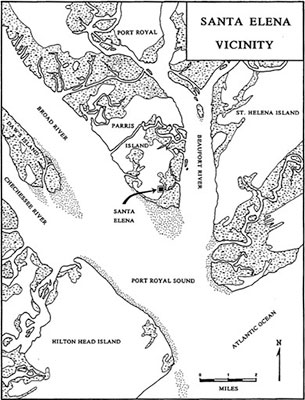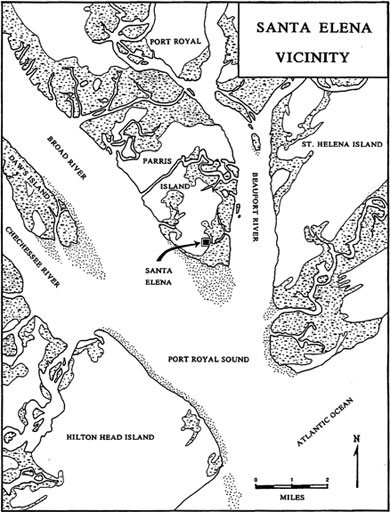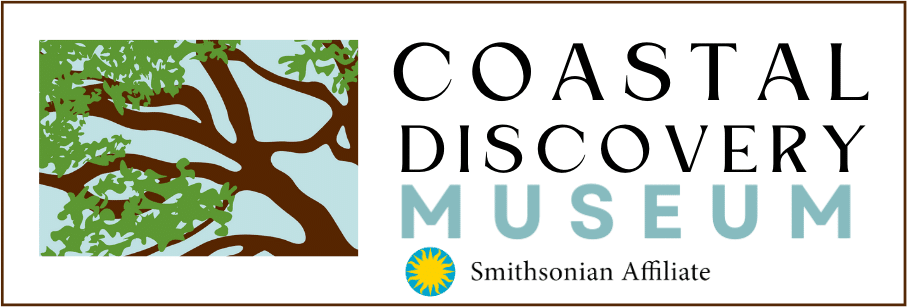In the mid-16th century, Spain and France competed for control of North America. The Spanish government believed it had exclusive rights to the continent by the blessing of the Catholic Church, and France disagreed.
To protect its Atlantic shipping route from English and French privateers, Spain colonized points along the Southeastern coast, from the Caribbean to the Carolinas. One of these outposts was Santa Elena, the first colonial capital of Spanish Florida. Spanish colonists founded Santa Elena in 1566 on Parris Island in Port Royal Sound in present-day South Carolina. Both French and Spanish colonists occupied the site during the 16th century.
Today, the Charlesfort-Santa Elena site is a National Historic Landmark, important for its associations with the 16th-century conflict between Spain and France for control of the New World and with officers Spaniard Pedro Menendez de Aviles and Frenchman Jean Ribault. The site is also considered archaeologically significant.
After Christopher Columbus opened the Americas to European colonization in 1492, private and royal ships loaded with valuable goods traveled between the colonies and Spain. One of the most important water routes was the Florida Straits between the Bahamas and the Florida coast, where a strong current carries ships east out of the Gulf of Mexico and then straight north up the Atlantic coast. During the colonial era, French and English ships waited in these straits to attack and loot silver-laden Spanish ships. To protect Spain’s interests, King Philip II of Spain decided to build towns on the Florida mainland coast.

(Source: DePratter, Chester B. and South, Stanley, “Discovery at Santa Elena: Boundary Survey” (1995). Research Manuscript Series. Book 223. pg. 3)
The king chose Spanish naval officer Pedro Menéndez de Avilés to be the adelantado, or governor, of Spanish Florida in 1565 and ordered him to establish military bases on the mainland. Adelantado was an elite military and administrative position created when the Christian Spaniards took the Iberian Peninsula back from the Muslim Moors. In Europe, the Spanish adelantados built fortified outposts in hostile areas and were responsible for bringing the surrounding region under Spanish control. In return for the adelantado’s work, the Spanish crown granted the individual economic privileges and honors. When it began colonizing the Americas, Spain continued to use this system. Other Spaniards who held the title adelantado of Florida before Menéndez were Ponce de Léon, two men by the name of Lucas Vásquez de Ayllón, Pánfilo de Narváez, Hernando de Soto and Tristan de Luna y Arellano. But Spain failed to establish a permanent settlement in Florida until the Menéndez expedition.
Menéndez is best known for founding St. Augustine, the oldest continuously occupied European city in the continental United States. But his first colonial capital was Santa Elena. At the time, “La Florida” was all of the land the Spanish thought to be north of Mexico. Before Menéndez arrived, his French rival, naval officer Jean Ribault, founded Charlesfort on Parris Island in 1562 and claimed the land for France. Ribault’s fort was a blockhouse made of logs and clay, thatched with straw and surrounded by a moat. Ribault’s expedition abandoned Charlesfort within a year and sailed south to found Fort Caroline. Menéndez arrived in the straits in 1565 and fought Ribault’s forces on land and at sea along the Florida coast. He drove the French colonists from the Southeast, destroyed their forts and reclaimed the territory for Spain.
When Menéndez arrived at Parris Island in 1566, he ordered his men to build a new fort, called San Salvador, and a few months later, he founded Santa Elena. Menéndez oversaw the construction of a larger fort, San Felipe, after 250 reinforcements arrived on the island in the summer of 1566. Two years later, 225 settlers – including farmers, Catholic missionaries, and families – arrived in Florida from Spain and supplemented the garrisons at St. Augustine and Santa Elena. Menéndez’s city government at Santa Elena issued land for the immigrants, and by 1569, there were 40 houses around the central plaza.
For 21 years following colonization in 1566, Santa Elena’s Spanish leadership struggled to keep the coastal village working. The island’s soil could not support the farming needed to feed everyone, resulting in food shortages. The Spanish were not on friendly terms with the Native Americans in the region – the Orista and Guale tribes – so the colonial farmers could not expand their farms beyond the fort’s protection. To reduce the number of people they had to feed, Menéndez’s lieutenant and kinsman, Esteban de las Alas, sent away all but 46 soldiers. This left the town vulnerable to attacks by the French and Native Americans. When ships from Spain arrived in 1571, carrying supplies and more colonists, they also brought a deadly sickness. At around the same time, a fire at San Felipe destroyed the fort. Menéndez’s son-in-law, Don Diego de Velasco, oversaw the construction of a new fort, also named San Felipe.
Menéndez passed away in September 1574, and the Florida adelantado title passed on to his daughter Catalina’s husband, Hernando de Miranda. Miranda arrived at Santa Elena from Spain in the winter of 1576. Upon arrival, Miranda had Velasco, who was married to Menéndez’s other daughter, arrested for mismanaging soldiers’ bonuses and took over the local government. The following summer, Miranda’s ill treatment of the Native Americans provoked violence, and the Guale and Orista together launched an assault on the settlement and its ships. The colonists fled the town and gathered at Fort San Felipe. When they were able, the surviving colonists and soldiers escaped from the island on small boats left undisturbed by the attackers. Behind them, the Guale and Orista burned the fort and sacked Santa Elena. Catalina and Miranda sailed back to Spain.
In 1577, the Spanish colonists returned to Santa Elena. Philip II appointed Menéndez’s nephew, Pedro Menéndez Márquez, as governor of Florida, which was no longer a private venture but a royal colony. Menéndez Márquez ordered his soldiers to build a new garrison, Fort San Marcos, and brought the Spanish colonists back. Under the new governor’s command, Spanish soldiers invaded the Guale and Orista towns, which were harboring French castaways, and regained control of the island by 1580. The Spaniards’ successes at Santa Elena were short-lived, as the threat of an English empire in North America began to emerge. This changed the Spaniards’ approach to colonizing Florida. In 1586, the Spanish at St. Augustine heard of Sir Walter Raleigh’s Roanoke Island Colony on the coast of North Carolina. Menéndez Márquez also feared Sir Francis Drake’s attacks in the Caribbean. As Drake made his way north, he raided Spanish settlements at Santo Domingo, Cartagena, and St. Augustine. The English intended to take Santa Elena, too, but the fleet overshot it.

(Source: DePratter, Chester B. and South, Stanley, “Discovery at Santa Elena: Boundary Survey” (1995). Research Manuscript Series. Book 223. pg 6)
In response to the English threat, Spain decided to shrink the scope of its Florida colony and consolidate its colonial towns to strengthen them. Menéndez Márquez returned to Santa Elena in 1587 and ordered his men to destroy the town infrastructure and the second Fort San Marcos. The Parris Island colonists moved to St. Augustine, and the Spanish abandoned Santa Elena for good. For two centuries after the Spanish left, Scottish and then English colonists occupied Port Royal Sound. The coastal region was a trading ground for American Indians and Europeans before plantations developed in the coastal Lowcountry in the early 1700s. South Carolina became part of the United States of America at the end of the 18th century, and the plantations thrived until the American Civil War.
In 1915, the United States Marine Corps created the Marine Corps Recruit Depot on Parris Island. Little was known about the Spanish at Parris Island when the Marines arrived and most of the written history focused on the French presence. While the Marines settled on the island, Major George Osterhout oversaw archaeological excavations at the site of one of the forts, which he believed was French, and Congress erected a monument to Jean Ribault in 1926. At the same time, a scholar of Spanish colonial studies, Hubert Eugene Bolton, began to publish articles about Spain’s presence on the island. In the 1950s, National Park Service historians re-examined artifacts recovered from Parris Island. They determined the artifacts were Spanish in origin and the “French” fort was likely Spain’s first Fort San Marcos.
Since the late 1970s, archaeologists have continued to investigate the site of Charlesfort-Santa Elena for clues about its past inhabitants and the way they lived. In addition to revealing evidence of early European colonization in America, the site is valuable for what it can reveal about adelantado town planning. The site of Santa Elena was never reoccupied fully after the Spanish left in 1587. Archaeologists today are able to explore the site to find information about what the town looked like in the 16th century. Excavations at Santa Elena reveal that the town had a central plaza with colonial buildings uniformly built around it. Visitors to Parris Island can learn about the island’s history at the nearby USMC Parris Island Museum.

